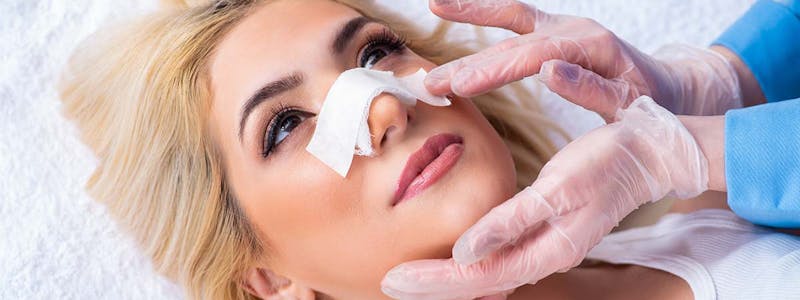
If you’re thinking about getting a rhinoplasty, it’s helpful to plan some extra downtime into your schedule. After the procedure, you’ll need some time to heal and recover from rhinoplasty, so you’re well enough to resume your normal functions like before with minimal risk of injury to your nose or damage to your new look. Though the procedure is quick, and patients go home right afterward, there are some things to consider about the length of recovery.
The average length of time it takes patients to get back to normalcy after rhinoplasty is eight weeks, though it takes one year to completely recover and for results to finalize. If you had rhinoplasty for functional purposes, you might also notice improvements in breathing. Here is a brief breakdown of what you can expect for the first year of recovery.
First Two Months After Rhinoplasty
During the first month or so, the bones, cartilage, and tissues of the nose are incredibly delicate and prone to damage. For the first week, patients wear a splint and a small cast or splint on their nose to protect it from the elements and potential trauma and support the tissues during the preliminary stages of the healing process. Patients are advised to modify their duties and avoid unnecessary events or activities that could lead to accidental falls or bumps to the nose.
Bandages and splints are removed during the first follow-up appointment. In cases where extensive work was necessary, bandage and splint removal may not occur until several days later. Though bandages are no longer necessary at this time, the nose is still quite fragile.
Activity and Lifestyle Considerations
 Patients should avoid certain activities, such as swimming, jogging, and other cardiovascular exercises or high-impact movements. These activities can stress or bounce the nose and are not safe to resume without medical clearance.
Patients should avoid certain activities, such as swimming, jogging, and other cardiovascular exercises or high-impact movements. These activities can stress or bounce the nose and are not safe to resume without medical clearance.
The bones and cartilage are still knitting and repairing. Unnecessary movements can interrupt the process and alter the procedure’s results. Most patients receive clearance for mild activities after the first month.
Many patients opt to resume work and light activities after taking the first few days after their procedure to rest and recover from rhinoplasty. By the second to the third week, most of the swelling should be gone.
Yet some soreness or discoloration may remain. These effects are often minor and tend to take a little longer to disappear. Periodic numbness and other mild sensations may occur as the nerves in the surgical area continue to heal.
Months Three and Beyond After Rhinoplasty
By the time the third or fourth month arrives, patients should no longer experience soreness, tenderness, or numbness from the procedure. Swelling is gone, and discoloration is minimal. Bruising may no longer have a dark color and instead have a yellowish tinge that will get lighter as time wears on.
Regular sports and high-impact activities are safe to resume. To avoid accidental injury and preserve their rhinoplasty results, patients should wear a safety guard and other appropriate facial safety gear. At this point, the nose has a new appearance and is much closer to its final look.
Improving Recovery After Rhinoplasty
As exciting as the thought of showing off your rhinoplasty results can be, it is essential to remain patient and exercise due diligence for at least the first year of recovery. Additional ways patients can speed up their rhinoplasty recovery include:
Use Elevation
During the first month, patients should rest with their head elevated to decrease blood flow and pressure to the nose and keep swelling down. Propping pillows behind the upper back head or sleeping in a recliner can help patients avoid accidentally disturbing their faces and the surgical area. Ice packs and over-the-counter pain meds may help minimize any discomfort during the first few weeks after rhinoplasty.
Good Nutrition
 Maintain a healthy diet. The nose tends to hold onto swelling longer than other areas of the body. This is predominantly why it takes most patients one-year to recover from rhinoplasty. Avoiding dehydration is key to preventing the body, especially the tissues in the nose, from retaining excess fluid and decreasing swelling and puffiness faster. A proper diet that optimizes overall health is essential in providing the body with the fuel it needs for a speedy recovery and desirable results.
Maintain a healthy diet. The nose tends to hold onto swelling longer than other areas of the body. This is predominantly why it takes most patients one-year to recover from rhinoplasty. Avoiding dehydration is key to preventing the body, especially the tissues in the nose, from retaining excess fluid and decreasing swelling and puffiness faster. A proper diet that optimizes overall health is essential in providing the body with the fuel it needs for a speedy recovery and desirable results.
Be Gentle With the Nose
Avoid excess sneezing and blowing or touching the nose unnecessarily. Some nasal dryness may occur and is normal. Nasal spray may help restore moisture to combat the discomfort. Patients should review personal remedies or medications with their surgeon before use.
Stop Smoking
Avoid smoking and secondhand smoke. Smoke and nicotine can be very damaging to the skin. It also increases the risk of bleeding, dryness, and irritation and can lead to less than desirable results.
Unfortunately, as with any elective cosmetic procedure, there are some cases where patients overestimate their results and find themselves unsatisfied with the final appearance of their noses. Rhinoplasty revisions are common and can help correct issues that patients are unsatisfied with. However, revisions are not an option for most patients until at least one year after their most recent rhinoplasty procedure.
Learn More Way to Recover from Rhinoplasty
Keep in mind that no two patients will have the same experience during and after rhinoplasty. Contact us to set up an appointment to discuss your situation with our surgeon to better understand how you can benefit from having your nose transformed with plastic surgery and additional measures that can help improve and quicken your rhinoplasty recovery.

